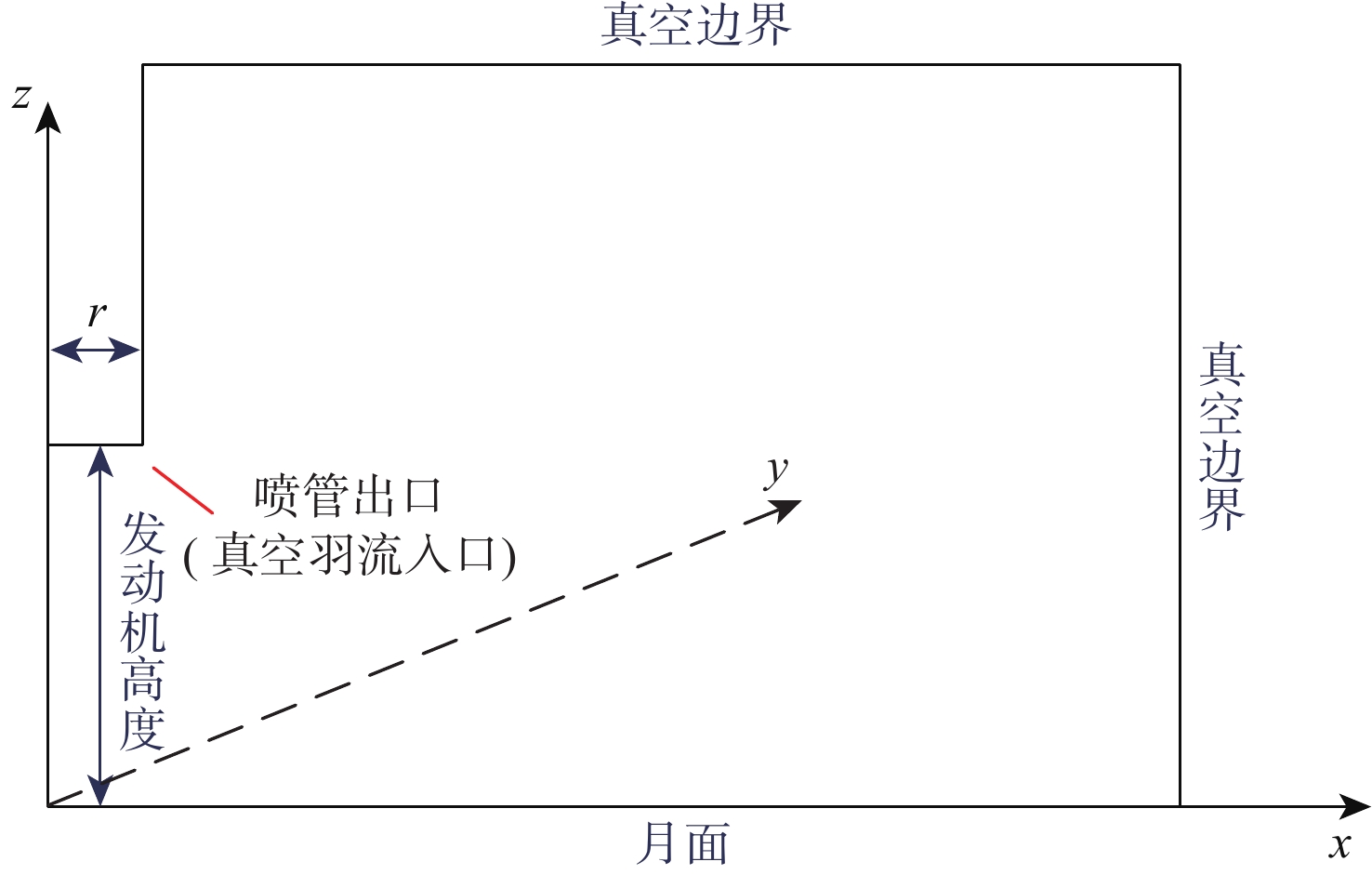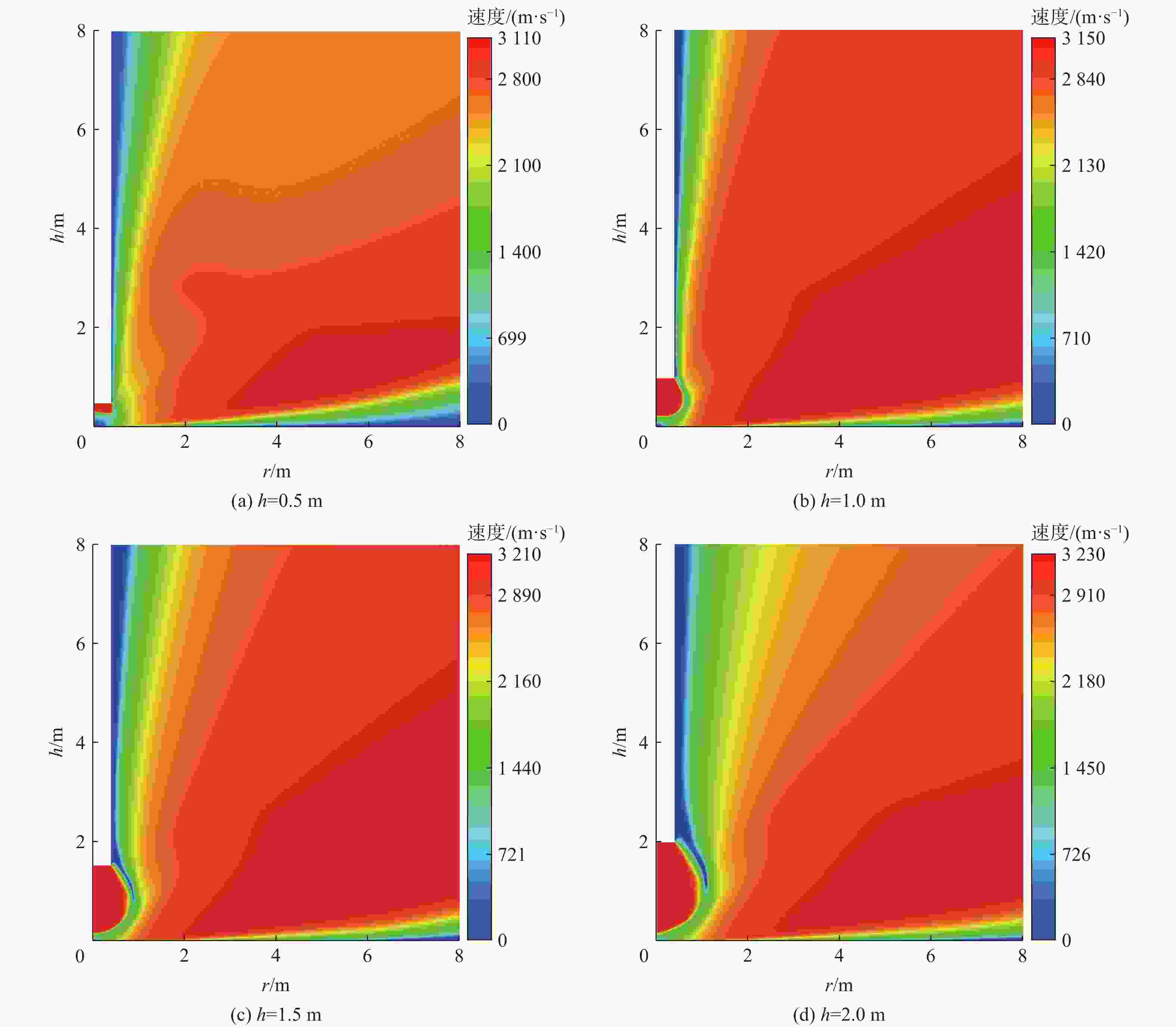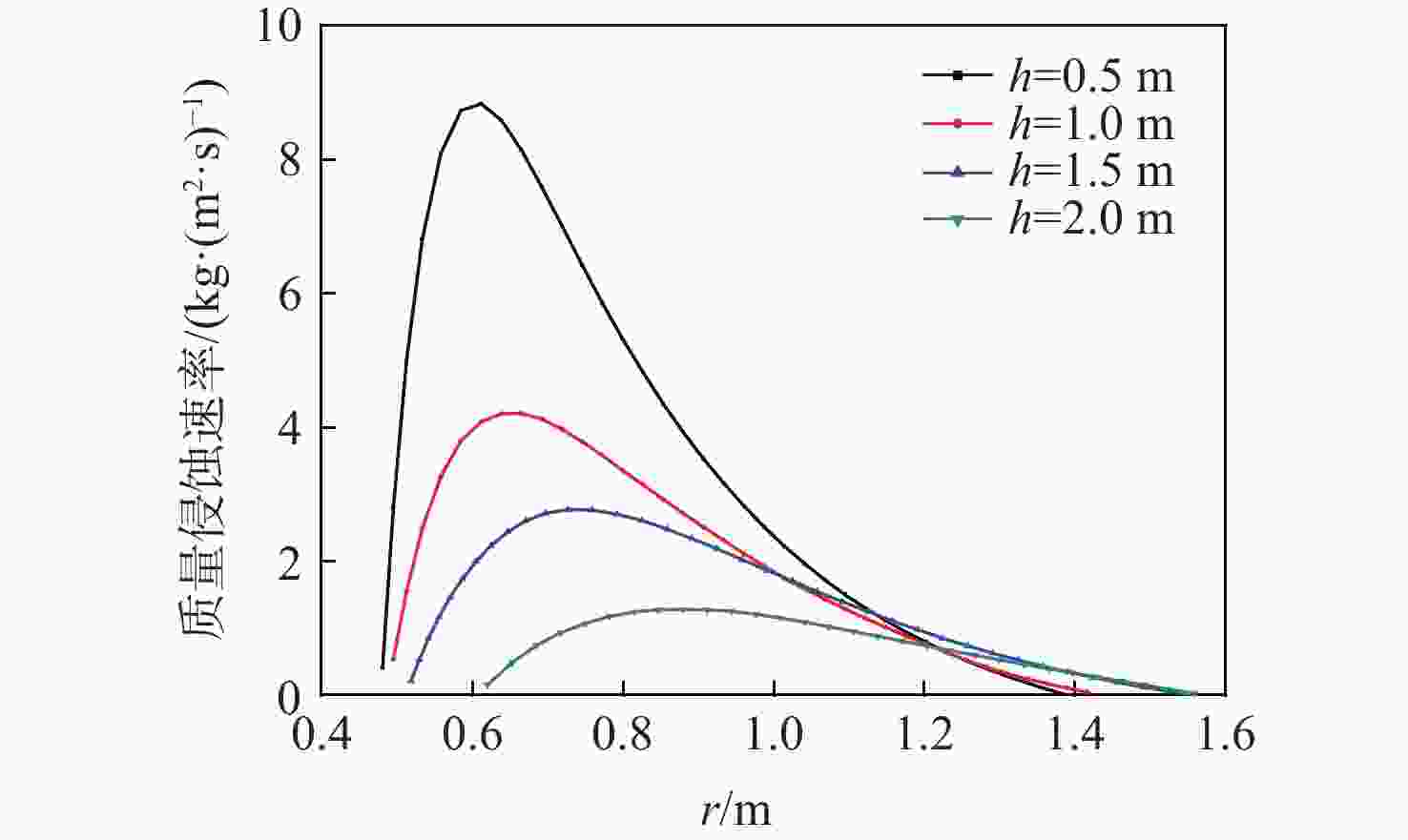-
摘要:
在月球探测器着陆过程中,发动机羽流与月面相互作用后溅起的月尘是月面环境危害的主要来源。本文以嫦娥五号任务测试数据作为仿真入口条件,采用计算流体动力学(CFD) 两阶段法建立了嫦娥五号任务中使用的喷管 1∶1 模型和真空羽流扩散侵蚀模型,研究了喷管在不同降落高度下的侵蚀速率,并计算了发动机距离月面高度为 0.5~2.0 m 范围时月尘颗粒的运动轨迹、扬尘角和速度特性。结果表明,基于剪切应力得到的最大侵蚀速率为8.83 kg/m2s,随着高度增加,侵蚀速率降低,与嫦娥五号降落相机相同高度下的分析结果一致。粒径为1、70 ìm 的月尘颗粒最大扬尘高度分别为 0.72、0.36 m,最大速度分别为 2520、1010 m/s。不同粒径月尘的扬尘角范围为 1.44°~2.27°,计算的扬尘角与 Apollo 探月任务中的结果相近。
Abstract:During a lander landing, the plume-lunar surface interaction induces lunar dust ejection, which is the main reason for lunar dust hazards. The study adopts computational fluid dynamics(CFD) method to build a one-toone nozzle model and vacuum plume flow and diffusion model, through which the lunar dust erosion mass is investigated, and the lunar dust trajectory, ejection angle and velocity are obtained when nozzle altitude is from 0.5 to 2.0 m. The results show that the maximum mass erosion rate is 8.83 kg/m2·s and this value decreases with nozzle altitude increase, which also is consistent with landing photo results in the Chang’E-5 mission. For lunar dust kinetic properties, the maximum velocity for 1 μm and 70 μm particles are 2 520 m/s and 1 010 m/s respectively, the maximum height for 1 μm and 70 μm particles are 0.72 m and 0.36 m respectively. The dust ejected angle ranges from 1.44° to 2.27°. The ejected angle calculated in Chang’E-5 mission is similar to that in Apollo mission.
-
表 1 发动机喷管出口流动参数仿真与实验结果对比
Table 1. Comparison of engine nozzle outlet flow parameters between simulation and ground test
方法 马赫数/Ma 压力/Pa 温度/K 速度/(m·s−1) 地面实验 5.22 170.02 744.69 3 218.56 仿真计算 4.93 175.83 802.32 3 032.12 表 2 不同高度处月尘最大扬尘角
Table 2. Lunar dust elevation angle at different nozzle altitudes
高度/m 粒径/μm 扬尘角/(°) 平均扬尘角/(°) 0.5 1 0.90 2.24 30 1.45 70 2.24 100 2.63 1.0 1 0.49 1.44 30 0.66 70 1.44 100 1.84 1.5 1 3.17 2.27 30 2.27 70 2.27 100 2.25 2.0 1 2.82 2.02 30 2.05 70 2.02 100 2.02 表 3 Apollo和嫦娥五号探月任务扬尘角对比
Table 3. Elevation angle comparison in Apollo and Chang’E-5 lunar exploration missions
任务名称 扬尘角/(°) 任务名称 扬尘角/(°) Apollo 11 2.6 Apollo 14 2.4 Apollo 15 8.1 Apollo 16 1.4 Apollo 17 2.0 嫦娥5号 1.44~2.27 -
[1] GAIER J R, HICKS M C, MISCONIN R M. Studies of simulated lunar dust on the properties of thermal-control surfaces[J]. Journal of Spacecraft and Rockets, 2013, 50(4): 848-852. doi: 10.2514/1.A32135 [2] JOHNSON C L, DIETZ K L. Effects of the Lunar Environment on Optical Telescopes and Instruments [C]//Proceedings of the Space Astronomical Telescopes and Instruments. Orlando: International Society for Optics and Photonics, 1991: 208-218. [3] PIRICH R, WEIR J, LEYBLE D, et al. Effects of the lunar environment on space vehicle surfaces [C]//2010 IEEE Long Island Systems, Applications and Technology Conferenc. Piscataway: IEEE, 2010: 1-6. [4] CAIN J R. Lunar dust: the hazard and astronaut exposure risks[J]. Earth, Moon, and Planets, 2010, 107(1): 107-125. doi: 10.1007/s11038-010-9365-0 [5] MORRIS A B, GOLDSTEIN D B, VARGHESE P L, et al. Plume impingement on a dusty lunar surface [C]//AIP Conference Proceedings. California: AIP, 2011: 1187-1192. [6] IMMER C, LANE J, METZGER P, et al. Apollo video photogrammetry estimation of plume impingement effects[J]. Icarus, 2011, 214(1): 46-52. doi: 10.1016/j.icarus.2011.04.018 [7] METZGER P T, IMMER C D, DONAHUE C M, et al. Jet-induced cratering of a granular surface with application to lunar spaceports[J]. Journal of Aerospace Engineering, 2009, 22(1): 24-32. doi: 10.1061/(ASCE)0893-1321(2009)22:1(24) [8] BÜHLER C A. Experimental investigation of lunar dust impact wear[J]. Wear, 2015, 342/343: 244-251. doi: 10.1016/j.wear.2015.09.002 [9] DONOHUE C M, METZGER P T, IMMER C D. Empirical Scaling Laws of Rocket Exhaust Cratering [EB/OL]. [2021-04-12]. http://arxiv.org/abs/2104.05176.pdf. [10] LANE J E, METZGER P T. Estimation of Apollo lunar dust transport using optical extinction measurements[J]. Acta Geophysica, 2015, 63(2): 568-599. doi: 10.1515/acgeo-2015-0005 [11] METZGER P T, LANE J E, IMMER C D, et al. Scaling of erosion rate in subsonic jet experiments and Apollo lunar module landings [C]//Earth and Space 2010. Reston, VA: American Society of Civil Engineers, 2010: 191-207. [12] LANE J E, METZGER P T, CARLSON J W. Lunar dust particles blown by lander engine exhaust in rarefied and compressible flow [C]//Earth and Space 2010: Engineering, Science, Construction, and Operations in Challenging Environments. Reston, VA: American Society of Civil Engineers, 2010: 134-142. [13] LANE J E, METZGER P T, IMMER C D, et al. Lagrangian trajectory modeling of lunar dust particles [C]//Earth & Space 2008. Reston, VA: American Society of Civil Engineers, 2008: 1-9. [14] MORRIS A B, GOLDSTEIN D B, VARGHESE P L, et al. Plume impingement on a dusty lunar surface[J]. AIP Conference Proceedings, 2011, 1333(1): 1187-1192. [15] MORRIS A B, GOLDSTEIN D B, VARGHESE P L, et al. Modeling the interaction between a rocket plume, scoured regolith, and a plume deflection fence [C]//Earth and Space 2012: Engineering, Science, Construction, and Operations in Challenging Environments. Reston, VA: American Society of Civil Engineers, 2012: 189-198. [16] MORRIS A B, GOLDSTEIN D B, VARGHESE P L, et al. Approach for modeling rocket plume impingement and dust dispersal on the moon[J]. Journal of Spacecraft and Rockets, 2015, 52(2): 362-374. doi: 10.2514/1.A33058 [17] LIEVER P, TOSH A, ARSLANBEKOV R, et al. Modeling of rocket plume impingement flow and debris transport in lunar environment [C]//Proceedings of the 50th AIAA Aerospace Sciences Meeting including the New Horizons Forum and Aerospace Exposition. Reston, Virigina: AIAA, 2012: 800. [18] HE X Y, HE B J, CAI G B. Simulation of two-phase plume field of liquid thruster[J]. Science China Technological Sciences, 2012, 55(6): 1739-1748. doi: 10.1007/s11431-012-4825-6 [19] RAHIMI A, EJTEHADI O, LEE K H, et al. Near-field plume-surface interaction and regolith erosion and dispersal during the lunar landing[J]. Acta Astronautica, 2020, 175: 308-326. doi: 10.1016/j.actaastro.2020.05.042 [20] ZHANG H H, LI J, WANG Z G, et al. Guidance navigation and control for Chang’E-5 powered descent[J]. Space:Science and Technology, 2021, 2021: 9823609. [21] LI Y, REN D P, BO Z G, et al. Gas-particle two-way coupled method for simulating the interaction between a rocket plume and lunar dust[J]. Acta Astronautica, 2019, 157: 123-133. doi: 10.1016/j.actaastro.2018.12.024 [22] BERG J J, GOLDSTEIN D B, VARGHESE P L, et al. DSMC simulation of europa water vapor plumes[J]. Icarus, 2016, 277: 370-380. doi: 10.1016/j.icarus.2016.05.030 [23] TSENG W L, LAI I L, IP W H, et al. The 3D direct simulation Monte Carlo study of Europa’s gas plume[J]. Universe, 2022, 8(5): 261. doi: 10.3390/universe8050261 [24] SLYUTA E N. Physical and mechanical properties of the lunar soil (a review)[J]. Solar System Research, 2014, 48(5): 330-353. doi: 10.1134/S0038094614050050 [25] COLWELL J E, BATISTE S, HORÁNYI M, et al. Lunar surface: dust dynamics and regolith mechanics[J]. Reviews of Geophysics, 2007, 45(2): 1-26. [26] LI C L, HU H, YANG M F, et al. Characteristics of the lunar samples returned by the Chang’E-5 mission[J]. National Science Review, 2022, 9(2): 188. doi: 10.1093/nsr/nwab188 [27] MORSI S A, ALEXANDER A J. An investigation of particle trajectories in two-phase flow systems[J]. Journal of Fluid Mechanics, 1972, 55(2): 193. doi: 10.1017/S0022112072001806 [28] MORRIS, A B. Simulation of rocket plume impingement and dust dispersal on the lunar surface[D]. Austin: University of Texas at Austin, 2012. -







 下载:
下载:













